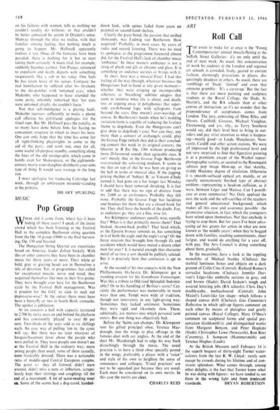ART
Roll Call
THE event to make for at once is the 'Young Contemporaries' annual muscle-flexing at the Suffolk Street Galleries: it's on only until the end of next week. As usual. this concentration of work by students at the London and regional art schools is crowded, lively, geared to current fashion, alarmingly precocious in places, dis- quietingly deadpan in others. As usual, there are rumblings of 'fixed; `slanted' and even that ominous grumble: 'It's a carve-up.' But the fact is that there are more painting and sculpture students at the Royal College, the Slade. St. Martin's, and the RA schools than at other centres of instruction, so it's no wonder that the preponderance of acceptances comes from London. The jury, consisting of Mme Riley and Messrs. Caulfield, Greaves, Michael Vaughan, Ehrenzweig, and yrs. trly., as Terry Southern would say, did their level best to bring in out- siders and pay strict attention to what is happen- ing—mostly good—at Leeds, Manchester, New- castle, Cardiff and other action stations. We were all impressed by the high professional level and not very surprised to find that figurative painting is at a premium, except of the Warhol repeat- photographic variety, or secured to the Rosenquist admass pop image blow-up, or that sketchy, skiddy Hockney degree of etiolation. Otherwise it is smooth-surfaced optical art, mainly, or an equally anonymously finished type of abstract emblem—representing a head-on collision, as it were, between Leger and Matisse. Can I pontifi- cate or even summarise? No. Only applaud the zest, the scale and the self-sacrifice of the teachers and general educational background, which makes all this ease and assurance possible—the permissive situation, in fact, which the youngsters have seized upon themselves. Not that anybody is trying to stop them. But for years I've been advo- cating ad hoc grants for artists in what are now known as 'the middle years'; when they're bogged down with families, teaching commitments, sheer fatigue, and would do anything for a year off, with pay. The Arts Council is doing something about them, gradually.
In the meantime, have a look at the toppling monoliths of Michael Stanley (Chelsea); the skeletal luminous boxes and objects on a dark ground of Colin Cina (Central); Richard Romes's surrealist headstone (Chelsea); Jennifer Dur- rant's Leger-like umbrella sections in grey, red and brown (Slade); David Inshaw's tough and assured lettering jobs (RA schools); Chris Day's double-cube, multicoloured (Central); John Maizel's Louis-like fan shape—which follows a shaped canvas drift (Chelsea); Gus Cummins's Reflection in which split-up figures comment on each other by means of plexiglass and gently painted canvas (Royal College); Mary O'Shea's comment on sculptural forms and spatial pre- sentation (Goldsmith's); and distinguished works from Margaret Benyon, and Peter Hopkins (Slade), Christopher Lowe (Newcastle), Ron Rees (Coventry), J. Sampson (Hammersmith) and Terence Hughes (Leeds).
At the British Museum until February 14 is the superb bequest of thirty-eight Turner water- colours from the late R. W. Lloyd: rarely seen except by crowds during his lifetime and of con- sistent splendour. What comes through, among other delights, is the fact that Turner knew what he was-doing with figures: we have tended to.see them in the wrong light and from irrelevant


































 Previous page
Previous page